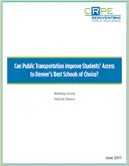Read the related blog.
Transportation is a vexing concern for cities like Denver that offer families school choice. A choice system can’t truly be equitable if the best schools aren’t accessible for large numbers of students.
To examine whether providing all Denver Public Schools (DPS) students with passes for Denver’s Regional Transit District (RTD) service could extend students’ access to schools, we linked administrative data from DPS with information about the RTD system. We found that Denver’s geography, segregation of communities, and uneven distribution of high-quality schools makes white students likelier to have easier access to the city’s highest-performing schools than students of color and those from low-income households. While our analysis shows that most students can reasonably use public transit to get to their current school, the highest-performing schools would remain difficult to access for many—especially students of color and those from low-income households. Importantly, the analysis only considered whether students could reach a high-quality school within 30 minutes on public transit, not whether students could actually enroll in that school. Many schools in Denver are sought by far more students than they can serve, and students living far away may have little chance of enrolling in them given that the system prioritizes proximity.
Findings that may apply to other high-choice cities wrestling with the challenge of transportation include:
- Public transit will not be an adequate substitute for a well-distributed supply of quality schools.
- Any individual school will always be unreachable to some students, so cities must think hard about the placement of highly specialized schools—for example, select arts academies—to ensure that the maximum number of students can reach them.
- For some students in isolated regions, access to quality schools can improve by considering options outside the district boundaries.
For Denver and other cities, the most enduring solution for improving access is to have more high-quality schools by improving existing schools, replicating higher-performing schools, or launching promising new schools in select neighborhoods. While such investments can be difficult, costly, and time-consuming, the results could result in dramatically improved access for the students most in need.





